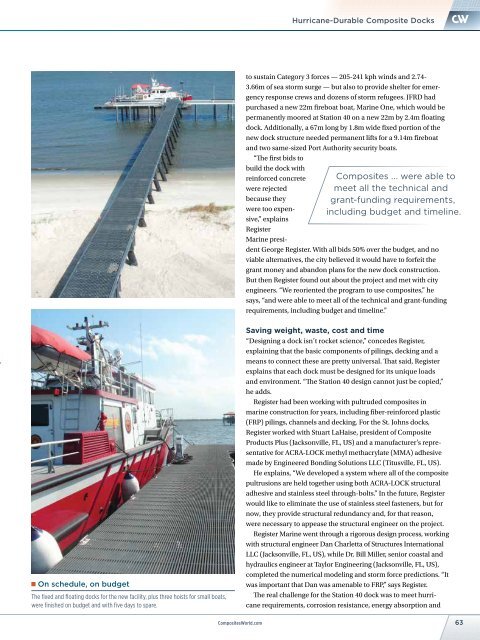FOR AUTO RTM
1VeKpGy
1VeKpGy
You also want an ePaper? Increase the reach of your titles
YUMPU automatically turns print PDFs into web optimized ePapers that Google loves.
Hurricane-Durable Composite NEWS Docks<br />
to sustain Category 3 forces — 205-241 kph winds and 2.74-<br />
3.66m of sea storm surge — but also to provide shelter for emergency<br />
response crews and dozens of storm refugees. JFRD had<br />
purchased a new 22m fireboat boat, Marine One, which would be<br />
permanently moored at Station 40 on a new 22m by 2.4m floating<br />
dock. Additionally, a 67m long by 1.8m wide fixed portion of the<br />
new dock structure needed permanent lifts for a 9.14m fireboat<br />
and two same-sized Port Authority security boats.<br />
“The first bids to<br />
build the dock with<br />
reinforced concrete Composites ... were able to<br />
were rejected<br />
meet all the technical and<br />
because they<br />
grant-funding requirements,<br />
were too expensive,”<br />
explains<br />
including budget and timeline.<br />
Register<br />
Marine president<br />
George Register. With all bids 50% over the budget, and no<br />
viable alternatives, the city believed it would have to forfeit the<br />
grant money and abandon plans for the new dock construction.<br />
But then Register found out about the project and met with city<br />
engineers. “We reoriented the program to use composites,” he<br />
says, “and were able to meet all of the technical and grant-funding<br />
requirements, including budget and timeline.”<br />
On schedule, on budget<br />
The fixed and floating docks for the new facility, plus three hoists for small boats,<br />
were finished on budget and with five days to spare.<br />
Saving weight, waste, cost and time<br />
“Designing a dock isn’t rocket science,” concedes Register,<br />
explaining that the basic components of pilings, decking and a<br />
means to connect these are pretty universal. That said, Register<br />
explains that each dock must be designed for its unique loads<br />
and environment. “The Station 40 design cannot just be copied,”<br />
he adds.<br />
Register had been working with pultruded composites in<br />
marine construction for years, including fiber-reinforced plastic<br />
(FRP) pilings, channels and decking. For the St. Johns docks,<br />
Register worked with Stuart LaHaise, president of Composite<br />
Products Plus (Jacksonville, FL, US) and a manufacturer’s representative<br />
for ACRA-LOCK methyl methacrylate (MMA) adhesive<br />
made by Engineered Bonding Solutions LLC (Titusville, FL, US).<br />
He explains, “We developed a system where all of the composite<br />
pultrusions are held together using both ACRA-LOCK structural<br />
adhesive and stainless steel through-bolts.” In the future, Register<br />
would like to eliminate the use of stainless steel fasteners, but for<br />
now, they provide structural redundancy and, for that reason,<br />
were necessary to appease the structural engineer on the project.<br />
Register Marine went through a rigorous design process, working<br />
with structural engineer Dan Charletta of Structures International<br />
LLC (Jacksonville, FL, US), while Dr. Bill Miller, senior coastal and<br />
hydraulics engineer at Taylor Engineering (Jacksonville, FL, US),<br />
completed the numerical modeling and storm force predictions. “It<br />
was important that Dan was amenable to FRP,” says Register.<br />
The real challenge for the Station 40 dock was to meet hurricane<br />
requirements, corrosion resistance, energy absorption and<br />
CompositesWorld.com 63


